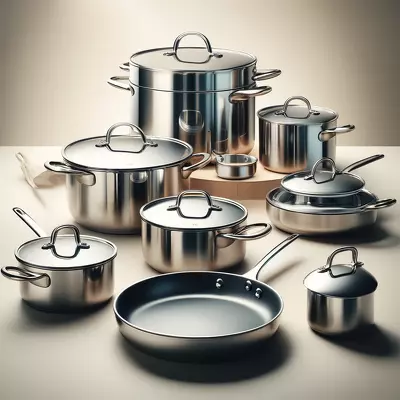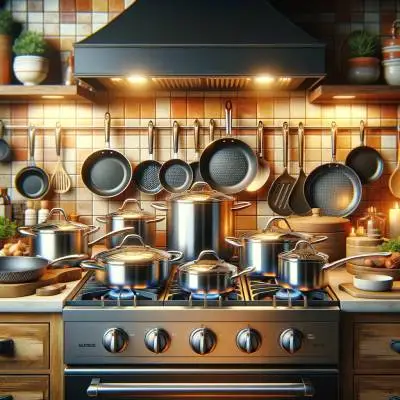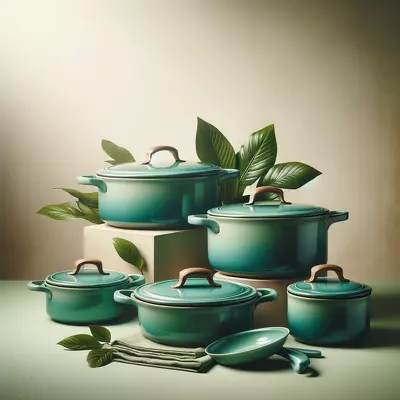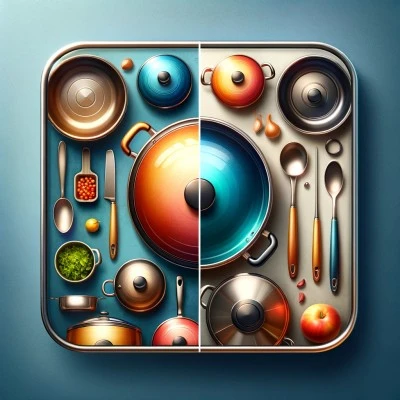Mastering the Art of Cooking: The Ultimate Guide to Essential Pots and Pans for the Kitchen
Navigating the myriad of cookware options can be overwhelming. However, a well-equipped kitchen doesn’t need an abundance of tools. A few key pieces can revolutionize the way you prepare meals, ensuring efficiency and enhancing flavors. This guide distills the vast selection to a core set of pots and pans, each integral for crafting an array of dishes, from simple breakfasts to elaborate dinners.
I. Introduction
A. Importance of Selecting the Right Cookware
Selecting the right cookware is more than a mere investment; it’s about creating a harmonious relationship between the chef and the kitchen. The right set of pots and pans not only simplifies the cooking process but also enhances the flavors and textures of the dishes prepared. Understanding the materials, heat conductivity, and durability of cookware can drastically improve one’s culinary experience, making every meal a testament to quality and precision.
B. Benefits of a Streamlined Kitchen Set
A streamlined kitchen set, characterized by essential and multi-functional pieces, paves the way for culinary creativity while minimizing clutter. By focusing on versatile and indispensable items, cooks can navigate their kitchen with ease, ensuring every tool serves multiple purposes. This approach not only economizes space but also simplifies decision-making during cooking, leading to a more organized and efficient culinary environment.
II. Essential Pots for the Kitchen
A. The Multi-purpose Saucepan
A true kitchen stalwart, the multipurpose saucepan is indispensable for a myriad of tasks. From simmering soups and sauces to boiling vegetables and grains, its versatility is unmatched. Opting for a saucepan with a heavy bottom ensures even heat distribution, preventing hotspots and promoting uniform cooking, a crucial aspect for delicate sauces and custards.
B. The Versatile Stockpot
For those hearty meals and large family gatherings, the versatile stockpot is a necessity. Ideal for brewing rich stocks, boiling pasta, or cooking stews, this pot excels in handling bulk cooking with ease. Its tall sides and ample volume make it an excellent choice for simmering flavors over extended periods, ensuring every ingredient melds perfectly into a harmonious dish.
C. The Indispensable Saute Pan
The saute pan, with its wide base and straight sides, is designed for searing and sautéing. Its construction allows for quick heat adjustment, making it perfect for dishes that require precise temperature control. Whether browning meat or wilting greens, the saute pan is a go-to for achieving the perfect texture and depth of flavor.
III. Essential Pans for the Kitchen
A. The Classic Frying Pan
A staple in any kitchen, the classic frying pan is essential for a wide range of cooking techniques. From frying and searing to scrambling and sautéing, its sloped sides and responsive heat control make it ideal for fast cooking. Choosing a pan with a reliable non-stick coating or well-seasoned surface can significantly enhance its performance and longevity.
B. The Dependable Cast Iron Skillet
Renowned for its durability and heat retention, the cast iron skillet is a legacy piece in many kitchens. Its ability to maintain high temperatures makes it perfect for searing steaks and creating a rich crust. Though it requires specific maintenance, its versatility extends from the stovetop to the oven, providing a consistent cooking experience for generations.
C. The Functional Non-stick Pan
For health-conscious cooks and those who value convenience, the functional non-stick pan is a game-changer. Its slick surface ensures easy food release and minimal oil usage, promoting healthier cooking practices. While it may not be as durable as its cast iron or stainless steel counterparts, its ease of cleaning and ability to cook delicate items like eggs and pancakes flawlessly makes it a valuable addition to the kitchen.
IV. Specialty Cookware
A. The Essential Dutch Oven
The Dutch oven, a heavy-duty pot with a tight-fitting lid, excels in slow cooking methods like braising and stewing. Its thick walls and even heat distribution encapsulate flavors, transforming simple ingredients into rich and comforting dishes. Whether used on the stovetop or in the oven, its versatility and durability make it a cherished piece for both casual cooks and professional chefs.
B. The Convenient Grill Pan
For those who crave the charred flavor of grilled food but are limited by space or weather, the grill pan is a convenient alternative. Its ridged surface imparts a distinctive grill mark on food, simulating an outdoor grill experience. It’s perfect for grilling vegetables, meat, and fish, providing a smoky flavor and appealing texture without leaving the comfort of the kitchen.
C. The Handy Wok
Originating from Asian culinary traditions, the wok is designed for the high-heat cooking technique of stir-frying. Its unique shape allows for quick and even heating, with a small amount of oil sufficing to cook a variety of ingredients crisply. Its deep, sloping sides make it ideal for tossing and stirring, ensuring each component of the dish is perfectly cooked and flavored.
V. Care and Maintenance of Cookware
A. Cleaning and Storing Tips
Proper care and maintenance can significantly extend the life of your cookware. Each material requires specific cleaning methods; for instance, cast iron should be cleaned without soap and dried immediately to prevent rust, while stainless steel can withstand more rigorous scrubbing. Storing cookware properly, using protective racks or separators, can prevent scratches and preserve the surface of each piece.
B. Seasoning and Preventing Damage
Certain cookware, like cast iron and some non-stick pans, benefits from seasoning, a process that involves coating the surface with oil and heating it to create a natural, protective layer. Regular seasoning not only improves the cooking surface but also enhances the flavor of the food. Additionally, using wooden or silicone utensils can prevent scratches and damage to delicate surfaces, ensuring your cookware remains in top condition.
C. When to Replace Your Cookware
While quality cookware can last for years, recognizing when to replace a piece is crucial for safety and performance. Warping, rusting, or flaking, especially in non-stick pans, are clear indicators that cookware has reached the end of its life. Upgrading to newer, more efficient pieces can improve cooking results and ensure safety in the kitchen.
VI. FAQs
Q: What are the key factors to consider when buying cookware?
A: Consider material, heat conductivity, maintenance requirements, and compatibility with your cooking habits. Durability and the ability to handle different heat sources are also crucial.
Q: How do I properly maintain cast iron cookware?
A: Clean with minimal soap, dry immediately, and season regularly with oil to maintain its non-stick properties and prevent rust.
Q: Can non-stick pans be used on high heat?
A: No, high heat can damage the non-stick coating. For longevity, it’s best to use them on low to medium heat.
Q: How often should I replace my cookware?
A: Replace when you notice warping, rusting, or flaking, particularly in non-stick pans, as these can indicate deterioration and potential health hazards.
Q: Is it worth investing in specialty cookware like a Dutch oven or wok?
A: Yes, if you frequently prepare dishes that require slow cooking or high-heat stir-frying. These pieces can enhance flavor and texture significantly.
Q: What is the best way to store pots and pans to ensure they last longer?
A: Store them with space between them to avoid scratching, and use protectors if you stack them. Keep them in a dry, cool place to prevent damage.
Q: Are there specific utensils recommended for different types of cookware?
A: Yes, use wooden or silicone utensils for non-stick and delicate surfaces to prevent scratching, and metal utensils for more durable materials like stainless steel.
VII. Conclusion
A. Investing in Quality Over Quantity
Investing in a few key, high-quality pieces of cookware can transform your cooking experience. Quality cookware not only lasts longer but also provides consistent heat distribution, enhancing the flavor and texture of your dishes. Making thoughtful choices about what to include in your kitchen ensures each piece is utilized to its fullest, reducing clutter and elevating your culinary creations.
B. The Impact of the Right Cookware on Culinary Success
The right cookware acts as a catalyst for culinary creativity and success. It encourages experimentation, ensures precision in cooking, and brings joy to the process. Embracing the essentials and understanding their impact can turn everyday cooking into an art form, making every meal an opportunity to create and indulge in a delicious experience.
VIII. Suggested Readings
Before selecting your next set of pots and pans, enrich your knowledge with these insightful reads available on Bing. From understanding the science behind cookware materials to mastering various cooking techniques, these books offer valuable information for both novice cooks and seasoned chefs.
- “Cookware and Culture” by Jeremy MacClancy – Explore the relationship between cookware, cuisine, and culture, offering a unique perspective on how the tools of the kitchen shape culinary traditions.
- “The Science of Cookware” by Dr. Stuart Farrimond – Delve into the science behind different materials and shapes, and how they affect cooking performance and food taste.
- “In the Kitchen: The New Bible of Home Cooking” by Michele Curtis and Allan Campion – A comprehensive guide offering tips on selecting cookware and mastering essential cooking techniques.
- “Pots, Pans, and Pioneers” by Louise Johnson – Discover the history and evolution of cookware, along with traditional recipes that have been passed down through generations.
- “The Cast Iron Skillet Cookbook” by Sharon Kramis and Julie Kramis Hearne – Focused on the versatile cast iron skillet, this book provides recipes and care tips to make the most of this essential kitchen tool.
These resources will not only guide your cookware choices but also inspire you to explore new culinary horizons. With the right knowledge and tools, the kitchen can become a place of endless creativity and satisfaction.






